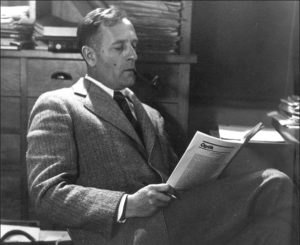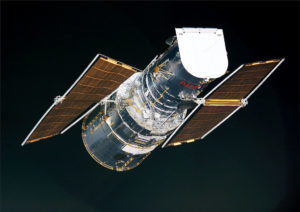In April of 2015, the Hubble Space Telescope will turn 25 years old, and in that quarter century, it has given scope to the imaginations of space geeks everywhere. Recently I saw a really neat photo that got me curious about the device, so I figured it’d make a great first space post here. I’ll tell you a little about the telescope itself, and some of its accomplishments.
The Hubble Behind the Hubble
It’s been known since the early days of telescopes that the atmosphere plays heck with focus and clarity beyond earth’s realms. It’s also what makes the stars “twinkle twinkle.” The idea for a space-based telescope first surfaced in the 1920’s; an official proposal was floated in the 1940’s, and the project was birthed in the 1970’s. Edwin Powell Hubble never worked on this telescope itself, but his name is applied to it for his contribution to the understanding of the expansion of the universe. The launch date was scheduled for 1986, but a few months prior to its launch, the space shuttleChallenger exploded shortly after liftoff and as a result delayed deployment for almost a year.
Nearsighted
Early in its deployment, NASA and the European Space Agency (ESA) discovered that Hubble had trouble focusing. The edge of the mirror was too flat, by less than 1/50th the width of a human hair. In response to the issue, the first Service Mission assigned, five mirrors were installed in carefully calculated positions, and Hubble’s myopia was cured.
Upkeep
Four Servicing Missions were conducted, the most recent one in 2009. Since the discontinuation of Space Shuttle missions in 2011, no further Servicing Missions have been scheduled. I guess it’ll be up to SpaceX or Virgin Galactic to do any further maintenance, but at this time, Hubble is running smoothly enough that no work is needed or anticipated.
Interesting Facts about the Hubble Telescope
Hubble is about as long as a school bus, not quite as wide (right around 7 feet) and weighs about as much as two full-grown elephants. Well, not in space, of course….
It takes a little over an hour and a half for Hubble to make it around the earth. That’s about 17,500 mph. It has made more than a million observations of more than 38,000 celestial bodies, producing more than 100 terabytes of data. (I’m actually surprised it’s not more!)
Amazing Discoveries–by no means a complete and comprehensive list:
- Photographs of a supernova
- Estimating the age of the universe (13 to 14 billion years)
- “Deep space” snapshots
- Identifying elements in and around extrasolar planets
- An honest-to-goodness black hole
- Gamma ray bursts caught on camera
- Where quasars live
- protoplanetary disks–possibly the birthplaces of new planets
- Jupiter’s injuries from potshots fired by Shoemaker-Levy
- The unique qualities of planetary nebulas
- Dark matter
- Two moons of Pluto
- dark energy–the force that accelerates the expansion of the universe
- Galaxies in all stages of evolution
WHO CAN USE THE TELESCOPE?
From HubbleSite.org: “any astronomer in the world can submit a proposal and request time on the telescope. Teams of experts then select the observations to be performed. Once observations are completed, the astronomers have a year to pursue their work before the data is released to the entire scientific community. ” About 4,000 astronomers have used it so far. (Did you even know there were 4,000 astronomers?)
You can read more about the Hubble Space Telescope at these sites: NASA: The Hubble Story ; The Hubble Site;

